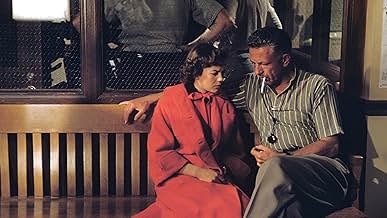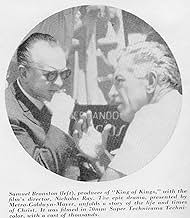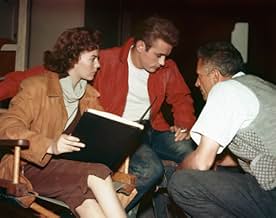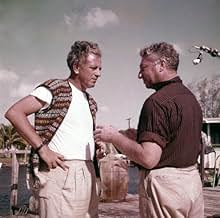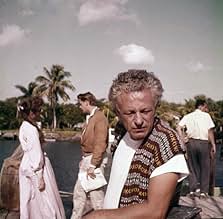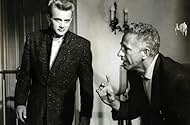Nicholas Ray(1911-1979)
- Director
- Writer
- Actor
Nicholas Ray was born Raymond Nicholas Kienzle in 1911, in small-town Galesville, Wisconsin, to Lena (Toppen) and Raymond Joseph Kienzle, a contractor and builder. He was of German and Norwegian descent. Ray's early experience with film came with some radio broadcasting in high school. He left the University of Chicago after a year, but made such an impression on his professor and writer Thornton Wilder that he was recommended for a scholarship withFrank Lloyd Wright,where he learned the importance of space and geography, not to mention his later love for CinemaScope. When political differences came between the seasoned architect and his young protégé, Ray left for New York and became immersed in the radical theater.
He joined the Theatre of Action, which is where he met his good friendElia Kazan,and later the Group Theatre. Times were tough and money was tight, but Ray loved the bohemian lifestyle of the close-knit group and enjoyed one of the happiest times of his life. Anybody who met him always noted his intellect and amazing energy. During this period he, along with his fellow Theater Group members, was also active in Socialist/Communist movement (which curiously went unnoticed during the Red Scare). In January 1937, Ray was put in charge of local theater activities by the Department of Agriculture's Resettlement Administration and moved to Washington with his wife Jean Evans, who was pregnant with his first child, Anthony. He also, along withAlan Lomax,traveled around the south and recorded folk musicians for the Library of Congress. The collaboration proved worthy, and in the early 40s Lomax and Ray were hired by CBS to produce a regular evening slot, headed byWoody Guthrie.In between this time Ray divorced his wife. Ray soon metJohn Houseman,who would become a very close friend. Houseman asked Ray to produce shows for the Overseas Branch of the Office of War Information, which ended quickly due to political pressures. Meanwhile, Ray's good friend of the Group Theatre daysElia Kazanhad been called to Hollywood to make his feature film debutA Tree Grows in Brooklyn (1945),and hired Ray to be his assistant, where Ray was first introduced to filmmaking. Houseman called Ray back to New York where Ray made his live TV debut with the enormously popularSorry, Wrong Number (1946),plus some other radio work.
In 1946 Houseman lent Ray the novel "Thieves Like Us" byEdward Anderson,and Ray fell in love with it; he was familiar with the Depression-era south. He worked hard at the adaptation, and though uncredited for the screenplay, Ray actually contributed a large amount to it. There was never any question of Ray directing the film, and under the sympathetic eyes of producers Houseman andDore Schary,who was well-known for giving first-time writers and directors breaks, Ray enjoyed possibly the only truly happy film making experience of his career. The film starsFarley GrangerandCathy O'Donnellas young, naive lovers trying to let their love blossom while running from the law. The film is remembered today for Ray's unique use of the camera (this was one of the first times a helicopter was used to shoot action), a fast pace, and above all, his extreme empathy for society's outsiders. Sadly, the film was shelved for two years due toHoward Hughes's takeover of RKO, and the film was released to a single theater in England to great reviews before it was finally released in the U.S.
Ray was eager to go back to work and quickly accepted a project without thinking. That film wasA Woman's Secret (1949),which Ray probably would've turned down had he though twice about going back to work, as it bears little of his fingerprints. The film is only memorable because it is where Ray met actressGloria Grahame,who became his second wife. Ray referred to the film as "a disastrous experience, among other things because I met her." When she became pregnant, Grahame divorced her husband and married Ray, because they thought it was the right thing to do. The same day that she became divorced, Ray and Grahame were wed in Las Vegas, but their marriage was over before it even started; Grahame spent their honeymoon alone while Ray gambled away nearly $40,000 in one night. Though RKO's publicity department alleged that Grahame and Ray met after Grahame's separation and that their son Timothy was born nearly 4 months premature, certain obvious truths contradict that statement. The marriage was disastrous; the two separated a year later and their attempt at professional friendship ended when Ray caught Grahame in bed with his son by Jean Evans. They divorced in 1952. AlthoughThey Live by Night (1948)was still unreleased in the US at this time, several Hollywood stars had their own private screening rooms and the film was seen by several important people.
One such person wasHumphrey Bogart,who was so impressed with the debut that he invited Ray to direct his first independent production,Knock on Any Door (1949),for a loan-out at Columbia. Though Bogart was initially puzzled by Ray's intensely emotional style of directing, the two had a lot in common and became good friends. The film became a modest success, but Ray had misgivings and later said, "I wishLuis Buñuelhad madeLos olvidados (1950)before I madeKnock on Any Door (1949),because I would have made a hell of a lot better film. "Indeed, though the subject (juvenile delinquents) is close to Ray's heart, the film is too perhaps too polemic for its own good. Back at RKO, Ray was obliged to make films close toHoward Hughes's heart but not to his own. Despite Ray's leftist views and previous association with the Communist Party, his friendship with Hughes benefited Ray for the better during the Red Scare, and Ray remained untouched, but was morally and contractually obligated to make films he had no care for, such asBorn to Be Bad (1950),which starred Hughes' one-time lover,Joan Fontaine,andFlying Leathernecks (1951),a blatant pro-war film that went against Ray's politics. Ray also did uncredited touch-up work to film such asRoseanna McCoy (1949),The Racket (1951),Androcles and the Lion (1952),andMacao (1952)during his years at RKO. Though Ray had his misgivings on their last collaboration, Bogart must have been impressed with Ray because he was optioned for a second loan-out at Columbia. Based loosely on a novel byDorothy B. Hughes,In a Lonely Place (1950)tells the story of a violent screenwriter who falls in love with a fellow Hollywood burnout while he is under investigation for a murder of a girl he barely knew. The story was changed drastically from the source novel and shaped to better suit Bogart, and the result is considered one of Bogart's best and most complex performances. Despite their marital problems, Ray insisted on castingGloria Grahamefor the role of Bogart's lover because he knew she was right for the role, and Grahame was praised for her work as well.
A critically acclaimed film at the time of its release but something of a box-office disappointment,In a Lonely Place (1950)has gained a reputation over the decades as a classic example of both film noir and existential, heartbreaking romance. Before his contract was finished at RKO, Ray was at least able to make two memorable films:On Dangerous Ground (1951)was a complex cop drama that again featured expressionistic camera moves (hand-held cameras were used, a rarity for the 1950s) and a look into a violent protagonist, andThe Lusty Men (1952),a film about the complexity of coming home was disguised as a rodeo movie. It is considered an underrated work of bothRobert Mitchumand Ray. After he left RKO, his first project was the pseudo WesternJohnny Guitar (1954),which he never liked and hated making (mostly because ofJoan Crawford) despite its box-office success. Today the film has gathered a cult status (Martin Scorseseis a big fan), and during this period the French New Wave directors began to take note of this American auteur;Jean-Luc Godardin particular idolized Ray and once stated that "the cinema is Nicholas Ray." In September of 1954, Ray wrote a treatment to "The Blind Run," about three troubled teenagers who create a new family in each other. This would form the basis for his most popular and influential film,Rebel Without a Cause (1955).After some re-writes, Ray started shopping for a lead actor. After a trip to the Strasberg Institute in New York proved fruitless, he learned thatElia Kazanhad recently discovered a New York stage actor for his latest film, but he wasn't recommending him; even after Ray saw a rough cut of this actor's latest film he still wasn't sure.
It was only when Ray met 24-year-oldJames Deanat a party did he realize that this hot new talent would be perfect for the role of Jim Stark, a troubled youth whose world is unraveled in a 24-hour period. Ray and Dean formed a very close bond during filming, with Ray allowing Dean to improvise and even direct to his liking. The rest of the cast came together with the talents of two fifteen-year-olds:Natalie Wood(to whom Ray was rumored to have made advances) andSal Mineo;as well as smaller roles, which Ray cast based on weeks of bizarre, improvised auditions as well as interviews with the actors. Filming was a wild ride, but it paid off; Mineo and Wood were both Oscar-nominated in the supporting acting categories, and Ray received his only Oscar nomination, for the screenplay.
Ray and Dean planned to make more movies after this, but Dean's death would never make that possible, and at least they left movie audiences with one great film. Ray loved working with younger actors and wanted to only make movies about them, but first he madeHot Blood (1956),based on research that his ex-wife had compiled about gypsies. During a stay in Paris Ray read an article called "Ten Feet Tall," about a teacher whose life fell apart because of a Cortisone addiction. Ray was fascinated by this and empathized with teachers' low pay at the time. Star and producerJames Masonplayed Ed Avery, a family man whose life takes a nightmarish turn when he becomes addicted to Cortisone. Though a critical and financial disaster, today Bigger Than Life is considered Nicholas Ray's masterpiece and very ahead of its time. The French magazine Cahiers du Cinema named it one of the 10 best films of the 50s. In fact, the magazine was a huge admirer of Ray, and frequently would acclaim Ray's films for their style and substance while American critics dismissed them, adding to Ray's cult status as a director. Ray continued to make films, but his health started to become a problem on the set ofWind Across the Everglades (1958),and Ray was fired, with most of his footage discarded.
In the 1960s, he was invited to make two big-budget films in Spain, the Biblical epicKing of Kings (1961)and55 Days at Peking (1963),where he suffered a heart attack brought on by years of heavy drinking and smoking, not to mention stress. This sadly brought his Hollywood career to a premature finish. After his heart attack, he tried many times to direct again, but no projects made it off the ground. In addition, Ray was frequently using drugs and immersing himself in the chaos of the 1960s and the hippie generation. He did not direct again until the satirical porn shortWet Dreams (1974).Also in the 1970s, he became a teacher at New York University (one of his students wasJim Jarmusch), and despite his eccentricity, he connected with his students and together they madeWe Can't Go Home Again (1973),half documentary and half fiction. With the help of his friendWim Wenders,he completed his last film,Lightning Over Water (1980),which was supposed to be about a painter dying of cancer and trying to sail to China to find a cure, but instead it became a sad documentary about Ray's last days.
Nicholas Ray died on June 6th, 1979 of lung cancer, but before his death he left the world some of the most painfully realized and contemporary motion pictures ever put on celluloid, and shared a fully realized vulnerability that will never be duplicated. Thirty years after his death, the cinema still is Nicholas Ray.
He joined the Theatre of Action, which is where he met his good friendElia Kazan,and later the Group Theatre. Times were tough and money was tight, but Ray loved the bohemian lifestyle of the close-knit group and enjoyed one of the happiest times of his life. Anybody who met him always noted his intellect and amazing energy. During this period he, along with his fellow Theater Group members, was also active in Socialist/Communist movement (which curiously went unnoticed during the Red Scare). In January 1937, Ray was put in charge of local theater activities by the Department of Agriculture's Resettlement Administration and moved to Washington with his wife Jean Evans, who was pregnant with his first child, Anthony. He also, along withAlan Lomax,traveled around the south and recorded folk musicians for the Library of Congress. The collaboration proved worthy, and in the early 40s Lomax and Ray were hired by CBS to produce a regular evening slot, headed byWoody Guthrie.In between this time Ray divorced his wife. Ray soon metJohn Houseman,who would become a very close friend. Houseman asked Ray to produce shows for the Overseas Branch of the Office of War Information, which ended quickly due to political pressures. Meanwhile, Ray's good friend of the Group Theatre daysElia Kazanhad been called to Hollywood to make his feature film debutA Tree Grows in Brooklyn (1945),and hired Ray to be his assistant, where Ray was first introduced to filmmaking. Houseman called Ray back to New York where Ray made his live TV debut with the enormously popularSorry, Wrong Number (1946),plus some other radio work.
In 1946 Houseman lent Ray the novel "Thieves Like Us" byEdward Anderson,and Ray fell in love with it; he was familiar with the Depression-era south. He worked hard at the adaptation, and though uncredited for the screenplay, Ray actually contributed a large amount to it. There was never any question of Ray directing the film, and under the sympathetic eyes of producers Houseman andDore Schary,who was well-known for giving first-time writers and directors breaks, Ray enjoyed possibly the only truly happy film making experience of his career. The film starsFarley GrangerandCathy O'Donnellas young, naive lovers trying to let their love blossom while running from the law. The film is remembered today for Ray's unique use of the camera (this was one of the first times a helicopter was used to shoot action), a fast pace, and above all, his extreme empathy for society's outsiders. Sadly, the film was shelved for two years due toHoward Hughes's takeover of RKO, and the film was released to a single theater in England to great reviews before it was finally released in the U.S.
Ray was eager to go back to work and quickly accepted a project without thinking. That film wasA Woman's Secret (1949),which Ray probably would've turned down had he though twice about going back to work, as it bears little of his fingerprints. The film is only memorable because it is where Ray met actressGloria Grahame,who became his second wife. Ray referred to the film as "a disastrous experience, among other things because I met her." When she became pregnant, Grahame divorced her husband and married Ray, because they thought it was the right thing to do. The same day that she became divorced, Ray and Grahame were wed in Las Vegas, but their marriage was over before it even started; Grahame spent their honeymoon alone while Ray gambled away nearly $40,000 in one night. Though RKO's publicity department alleged that Grahame and Ray met after Grahame's separation and that their son Timothy was born nearly 4 months premature, certain obvious truths contradict that statement. The marriage was disastrous; the two separated a year later and their attempt at professional friendship ended when Ray caught Grahame in bed with his son by Jean Evans. They divorced in 1952. AlthoughThey Live by Night (1948)was still unreleased in the US at this time, several Hollywood stars had their own private screening rooms and the film was seen by several important people.
One such person wasHumphrey Bogart,who was so impressed with the debut that he invited Ray to direct his first independent production,Knock on Any Door (1949),for a loan-out at Columbia. Though Bogart was initially puzzled by Ray's intensely emotional style of directing, the two had a lot in common and became good friends. The film became a modest success, but Ray had misgivings and later said, "I wishLuis Buñuelhad madeLos olvidados (1950)before I madeKnock on Any Door (1949),because I would have made a hell of a lot better film. "Indeed, though the subject (juvenile delinquents) is close to Ray's heart, the film is too perhaps too polemic for its own good. Back at RKO, Ray was obliged to make films close toHoward Hughes's heart but not to his own. Despite Ray's leftist views and previous association with the Communist Party, his friendship with Hughes benefited Ray for the better during the Red Scare, and Ray remained untouched, but was morally and contractually obligated to make films he had no care for, such asBorn to Be Bad (1950),which starred Hughes' one-time lover,Joan Fontaine,andFlying Leathernecks (1951),a blatant pro-war film that went against Ray's politics. Ray also did uncredited touch-up work to film such asRoseanna McCoy (1949),The Racket (1951),Androcles and the Lion (1952),andMacao (1952)during his years at RKO. Though Ray had his misgivings on their last collaboration, Bogart must have been impressed with Ray because he was optioned for a second loan-out at Columbia. Based loosely on a novel byDorothy B. Hughes,In a Lonely Place (1950)tells the story of a violent screenwriter who falls in love with a fellow Hollywood burnout while he is under investigation for a murder of a girl he barely knew. The story was changed drastically from the source novel and shaped to better suit Bogart, and the result is considered one of Bogart's best and most complex performances. Despite their marital problems, Ray insisted on castingGloria Grahamefor the role of Bogart's lover because he knew she was right for the role, and Grahame was praised for her work as well.
A critically acclaimed film at the time of its release but something of a box-office disappointment,In a Lonely Place (1950)has gained a reputation over the decades as a classic example of both film noir and existential, heartbreaking romance. Before his contract was finished at RKO, Ray was at least able to make two memorable films:On Dangerous Ground (1951)was a complex cop drama that again featured expressionistic camera moves (hand-held cameras were used, a rarity for the 1950s) and a look into a violent protagonist, andThe Lusty Men (1952),a film about the complexity of coming home was disguised as a rodeo movie. It is considered an underrated work of bothRobert Mitchumand Ray. After he left RKO, his first project was the pseudo WesternJohnny Guitar (1954),which he never liked and hated making (mostly because ofJoan Crawford) despite its box-office success. Today the film has gathered a cult status (Martin Scorseseis a big fan), and during this period the French New Wave directors began to take note of this American auteur;Jean-Luc Godardin particular idolized Ray and once stated that "the cinema is Nicholas Ray." In September of 1954, Ray wrote a treatment to "The Blind Run," about three troubled teenagers who create a new family in each other. This would form the basis for his most popular and influential film,Rebel Without a Cause (1955).After some re-writes, Ray started shopping for a lead actor. After a trip to the Strasberg Institute in New York proved fruitless, he learned thatElia Kazanhad recently discovered a New York stage actor for his latest film, but he wasn't recommending him; even after Ray saw a rough cut of this actor's latest film he still wasn't sure.
It was only when Ray met 24-year-oldJames Deanat a party did he realize that this hot new talent would be perfect for the role of Jim Stark, a troubled youth whose world is unraveled in a 24-hour period. Ray and Dean formed a very close bond during filming, with Ray allowing Dean to improvise and even direct to his liking. The rest of the cast came together with the talents of two fifteen-year-olds:Natalie Wood(to whom Ray was rumored to have made advances) andSal Mineo;as well as smaller roles, which Ray cast based on weeks of bizarre, improvised auditions as well as interviews with the actors. Filming was a wild ride, but it paid off; Mineo and Wood were both Oscar-nominated in the supporting acting categories, and Ray received his only Oscar nomination, for the screenplay.
Ray and Dean planned to make more movies after this, but Dean's death would never make that possible, and at least they left movie audiences with one great film. Ray loved working with younger actors and wanted to only make movies about them, but first he madeHot Blood (1956),based on research that his ex-wife had compiled about gypsies. During a stay in Paris Ray read an article called "Ten Feet Tall," about a teacher whose life fell apart because of a Cortisone addiction. Ray was fascinated by this and empathized with teachers' low pay at the time. Star and producerJames Masonplayed Ed Avery, a family man whose life takes a nightmarish turn when he becomes addicted to Cortisone. Though a critical and financial disaster, today Bigger Than Life is considered Nicholas Ray's masterpiece and very ahead of its time. The French magazine Cahiers du Cinema named it one of the 10 best films of the 50s. In fact, the magazine was a huge admirer of Ray, and frequently would acclaim Ray's films for their style and substance while American critics dismissed them, adding to Ray's cult status as a director. Ray continued to make films, but his health started to become a problem on the set ofWind Across the Everglades (1958),and Ray was fired, with most of his footage discarded.
In the 1960s, he was invited to make two big-budget films in Spain, the Biblical epicKing of Kings (1961)and55 Days at Peking (1963),where he suffered a heart attack brought on by years of heavy drinking and smoking, not to mention stress. This sadly brought his Hollywood career to a premature finish. After his heart attack, he tried many times to direct again, but no projects made it off the ground. In addition, Ray was frequently using drugs and immersing himself in the chaos of the 1960s and the hippie generation. He did not direct again until the satirical porn shortWet Dreams (1974).Also in the 1970s, he became a teacher at New York University (one of his students wasJim Jarmusch), and despite his eccentricity, he connected with his students and together they madeWe Can't Go Home Again (1973),half documentary and half fiction. With the help of his friendWim Wenders,he completed his last film,Lightning Over Water (1980),which was supposed to be about a painter dying of cancer and trying to sail to China to find a cure, but instead it became a sad documentary about Ray's last days.
Nicholas Ray died on June 6th, 1979 of lung cancer, but before his death he left the world some of the most painfully realized and contemporary motion pictures ever put on celluloid, and shared a fully realized vulnerability that will never be duplicated. Thirty years after his death, the cinema still is Nicholas Ray.


